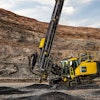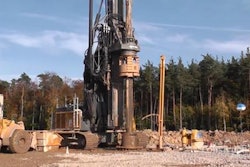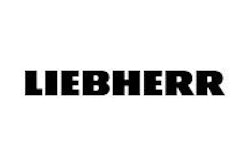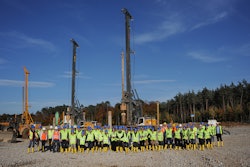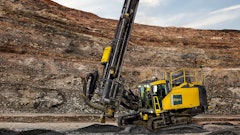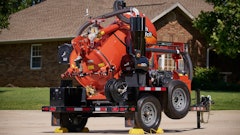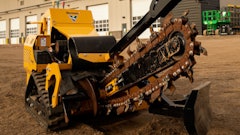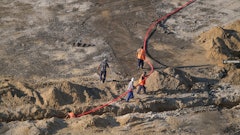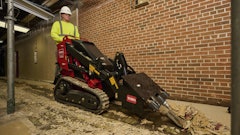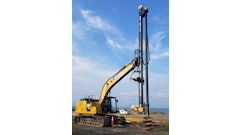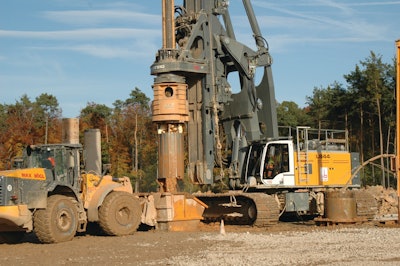
Last week, a group of 40 journalists from 13 countries witnessed Liebherr Construction Equipment’s new LB 44-510 rotary drilling rigs in action on a high-level research project in Darmstadt, Germany.
One of the world’s largest research facilities, the FAIR (Facility for Antiproton and Ion Research) international particle accelerator is under construction at a site roughly 20 miles south of Frankfurt. A ring accelerator with a circumference of 3,609 ft. (1.1 km) will ultimately form the heart of the site. This synchrotron is linked to a complex system of storage rings and experimentation stations.
A tunnel will be built to house the ring accelerator, while 24 buildings and tunnel sections will provide 74,151 sq. yds. (62,000 sq. m) of usable space and sufficient room for a total of 2.2 miles (3.5 km) of beam control tubes, as well as huge detectors and a complex technical infrastructure. Nearly 35,000 tons of steel and 784,770 cu. yds. (600,000 m³) of concrete will be used on the $688.5 million ($500 million Euro) project.
Going to Great Depths
Rotary drilling rigs are being employed on the 49.4-acre (200,000 sq. m) construction site to stabilize the subsurface with cast-in-place drilled piles. These operations form the basis for the construction of the particle accelerator.
The lead contractor on the project is the "FAIR Bohrpfähle" joint venture comprising Züblin Spezialtiefbau GmbH (engineering management) and Max Bögl GmbH & Co. KG (commercial management). In addition to other drilling equipment, each company provided an LB 44-510 to the joint venture.
Some 1,400 foundation piles with a length between 131 to 203 ft. (40 and 62 m) have been set in the ground since March 2013 to stabilize the foundation ground and provide a solid basis for the heavy buildings. At peak times, as many as 600 construction workers, technicians and engineers are employed on the site.
The first series production unit of the LB 44-510 was delivered in August. Since mid-September, another LB 44-510 has been on the site working in kelly drilling application. Despite their size, the 170-tonne LB 44-510 rotary drilling rigs can be quickly be set up using a quick assembly system. On the FAIR site, the two LB 44-510 units were ready for operation in just six hours.
Video: Liebherr L44 Drilling Rig at Work at the FAIR Construction Site
All drilled piles on the FAIR site are installed down to the final depth completely cased. This means that during the drilling process, the excavated material is removed under the protection of an advancing casing. Because of the high groundwater level and the partially unstable ground, a water load is needed throughout the pile manufacturing process to stabilize the bottom of the bore holes.
A drill bucket is used to loosen and remove the drill cuttings. In the past, two duty cycle crawler cranes with a casing oscillator were required to reinforce the piles and for concreting in order to guarantee the necessary torque and pull force when extracting the casing during concreting work. By using the rotary drilling method, the bore holes can be excavated down to the final depth completely cased, without the need for a casing oscillator. The high torque (376,000 lbs.-ft.) and pull force (123,000 lbs.) of the LB 44-510 allow this procedure to be accomplished to the required the depth, allowing for greater productivity.
Working in a drinking water protection zone also meant special requirements when preparing the piles. To this end, around 30 piles are fitted with sophisticated measuring equipment for monitoring the forces on the piles and any subsidence.
Far-reaching Research
The new facility, which is scheduled for completion in 2018, is being built in the immediate vicinity of the GSI Helmholtzzentrum für Schwerionenforschung (Helmholz Center for Heavy Ion Research), where the existing accelerator will serve as an injector for FAIR. Extremely intensive high-precision beams of antiprotons and ions from the entire range of elements will be generated for use by some 3,000 scientists from around 50 countries for researching rarely observed particle collision products.
Plans include using the research institution to investigate how the universe developed from the big bang to the present day, and to decode the building blocks of matter. In addition, FAIR should help to develop new medicinal therapeutic and diagnostic procedures, energy efficient high-performance computers and new materials for use in such applications as interplanetary space travel.

